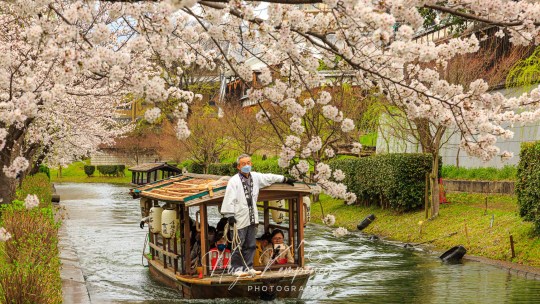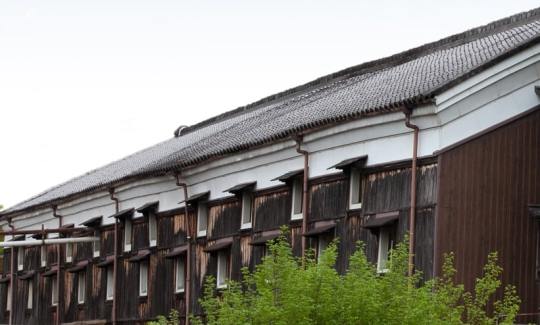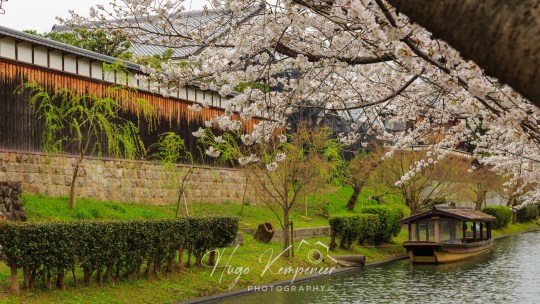#Sanjikkoku
Photo

Cherry Blossoms Along the Benten Bridge in Fushimi-Ku, Kyoto City-Japan.
#Benten Bridge#Benten-Hama#Cherry blossom#Chushojima#Fushimi-ku#Hanami#Japan#Jikkokubune Canal Cruise#Kyo-Bashi Bridge#Kyoto#Motozaimoku-cho#Sakura#Sanjikkoku#Toyotomi Hideyoshi#Uji River#matsuri#十石舟めぐり#弁天橋#花見
79 notes
·
View notes
Text
Kitagawa Honke Co., Ltd.


Adresse 370-6 Murakamicho, Fushimi, Kyoto Date de création 29 mai 1936 Représentant Yukihiro Kitagawa Histoire Kitagawa Honke fut fondée à Fushimi, à Kyoto, en 1657 (3e année de l’ère Meireki, du-rant l’époque d’Edo. Au début de l’époque d’Edo, le brassage du saké démarra avec le premier Shirobei Kitagawa, qui tenait un hangar à bateaux nommé Funaya, près de Bun-gobashi (Pont Kangetsu), sur les bords de la rivière Uji (ou fleuve Yodo), fabriquant son propre saké afin de le servir aux clients. En 1657, il y avait 83 brasseries à Fushimi ; c’est alors que le système Sakekabu* fut introduit. Le saké de Funaya est le plus célèbre de Fu-shimi et fut acheminé de Fushimi à Osaka par le fleuve Yodo sur le bateau Sanjikkoku**. On raconte que le saké fut transporté par la mer jusqu’à Edo, l’actuelle Tokyo, où il en-voûta la langue de Ono no Azumabito***.
* un ensemble de règles mises en place par le shogunat d’Edo qui pose les premiers prin-cipes fondamentaux du brassage du saké.
** transport maritime sur la rivière Yodo, qui part de Fushimi et rejoint Osaka.
*** Les personnes qui vivaient à l’Est de Kyoto et d’Osaka, soit si l’on grossit un peu le trait les habitants de l’actuelle Tokyo, Edo. Caractéristiques de l'entrepôt, philosophie de fabrication Dévoués à la nourriture et à la culture de Kyoto dans l’environnement béni de Fushimi, à Kyoto, et son eau abondante, nous respectons les techniques et ingrédients traditionnels transmis depuis plus de 350 ans. Nous avons peaufiné davantage nos techniques traditionnelles et avons remporté un to-tal de 18 médailles d’or à l’Institut National de Recherche sur le Brassage (depuis le mois de mars 2020). En introduisant un équipement moderne ainsi que les toutes dernières technologies, nous nous efforçons de combi-ner notre machinerie de pointe avec nos compétences humaines afin d’offrir à nos clients un saké de grande qualité. Dans le brassage du saké, l’organisation du travail en équipes est très important. Tous nos employés ne fabriquent pas seulement du bon saké, ils travaillent également cons-ciencieusement au maintien de l’innocuité et de la sécurité alimentaire. Nous honorons également nos responsabilités sociales en tant qu’entreprise et travaillons pour nous assurer de pouvoir répondre aux différentes re-quêtes de nos clients. Nous souhaitons transmettre notre technologie et la culture existant depuis des années aux générations futures. Nous désirons continuer à fabriquer un saké de qualité qui ravira la plupart des gens et souhaitons vous remercier pour vos nombreuses années de conseils et de soutien. Nous continuerons à travailler dur pour conserver notre clientèle. Caractéristiques de la région — géographie/météo/culture locale, etc. La culture du riz en rizière a commencé tôt à Fukakusa, premier endroit dans le bassin de Kyoto à utiliser cette pratique. Fushimi Inari Taisha, le grand sanctuaire principal du Sanctuaire Inari, fut fondé par le clan Hata sous l’influence des clans immigrés. Durant la période Tensho, le Château de Fushimi et les résidences de daimyo se regroupèrent à Momoyama; faisant de la ville un centre politique majeur, tandis qu'une ville fortifiée cen-trée sur de grands commerces fut édifiée dans les plaines le long de la rivière Yodo qui coule vers l’ouest. Elle était rattachée à Kyoto par des routes et par la rivière Takase. Le Canal Kamogawa et la voie ferrée ont ouvert tôt, au début de l’ère Meiji, transportant des biens provenant des différentes parties de Tokyo. Les industries telles que le brassage du saké prospérèrent en conséquence. Précipitations annuelles/chutes de neige/ensoleillement Précipitations annuelles:1491,3 mm, chutes de neige annuelles:19 cm, Ensoleillement annuel:148 jours Températures annuelles max./min. (℃) Température annuelle maximale:33,3℃, température minimale:1,2℃

0 notes
Text
Kitagawa Honke Co.,ltd.


Address 370-6 Murakamicho, Fushimi Ward, Kyoto Date Established 1936/5/29 Representative Yukihiro Kitagawa History Kitagawa Honke was founded in Fushimi, Kyoto in 1657 (Meireki 3) during the Edo period.In the early Edo period, sake brewing began with the first Shirobei Kitagawa, who ran a boathouse called Funaya, near Bungobashi (Kangetsu Bridge) along Uji River (Yodo River), making his own sake to serve to customers. There were 83 breweries in Fushimi in 1657, when the Sakekabu System *was first introduced. Funaya’s sake is the most famous sake in Fushimi, which was brought via the Yodo River on the Sanjikkoku boat**, from Fushimi to Osaka. The sake was carried to Edo (Tokyo)by sea, where it captivated the tongue of the Azumabito***.Unfortunately, there are no materials left to document the time before this period, but we think our brewery was founded in 1657 (Meireki 3).
*A basic policy of brewing regulations set out by the Edo Shogunate.
**Water transportation on the Yodo River, which runs between Fushimi and Osaka.
***The people who lived east of Kyoto and Osaka. More reductively, the people in Edo (Tokyo). Warehouse Features, Manufacturing Philosophy Committed to the food and culture of Kyoto in an environment blessed with abundant water in Fushimi, Kyoto, we have been adhering to the traditional techniques and ingredients passed down for more than 350 years. We have further refined our traditional techniques, and have won a total of 18 gold prizes at the National Research Institute of Brewing (as of March 2020). By actively introducing modern equipment as well as the latest technologies, we strive to combine our cutting-edge machinery and human skills to provide our customers with truly valuable sake. In brewing sake, the team in which one works is important. All of our employees will not only make good sake, but will also work diligently to maintain food safety and security. We will also fulfill our social responsibilities as a company, and work to ensure that we can respond to various requests from our customers. We want to pass on our technology and culture that have been around for many years to future generations. We want to continue making valuable sake that will please more people, and we want thank you for your many years of guidance and assistance. We will continue to work hard to keep your patronage. Features of the Area (Geography/Weather/Local Culture, etc.) Paddy rice cultivation began early in Fukakusa, which was the first place in the Kyoto basin to begin the practice.Fushimi Inari Taisha, the grand head shrine of Inari Shrine, was founded by the Hata Clan among influential migrant clans. In the Tensho Period, Fushimi Castle and a group of daimyo residences were formed in Momoyama as a major political city, while a castle town centered on big traders formed in the lowland along the Yodo river running west. It was connected to Kyoto by roads and the Takase River.The Kamogawa Canal and railway were opened early in the Meiji era, transporting goods from various places to Kyoto. Industries such as sake brewing boomed accordingly. Annual rainfall/snowfall/sun Annual rainfall:1491.3 mm, Annual snowfall:19 cm, Annual sunshine:148 days Annual high/low temperatures (℃) Annual maximum temperature:33.3℃, minimum temperature:1.2℃

0 notes
Photo

Cherry Blossoms Along the Benten Bridge in Fushimi-Ku, Kyoto City-Japan.
#Benten Bridge#Benten-Hama#Cherry blossom#Chushojima#Fushimi-ku#Hanami#Japan#Jikkokubune Canal Cruise#Kyo-Bashi Bridge#Kyoto#Motozaimoku-cho#Sakura#Sanjikkoku#Toyotomi Hideyoshi#Uji River#matsuri#十石舟めぐり#弁天橋#花見
19 notes
·
View notes
Photo

Cherry Blossoms Along the Benten Bridge in Fushimi-Ku, Kyoto City-Japan.
#Benten Bridge#Benten-Hama#Cherry blossom#Chushojima#Fushimi-ku#Hanami#Japan#Jikkokubune Canal Cruise#Kyo-Bashi Bridge#Kyoto#Motozaimoku-cho#Sakura#Sanjikkoku#Toyotomi Hideyoshi#Uji River#matsuri#十石舟めぐり#弁天橋#花見
12 notes
·
View notes
Photo

Cherry Blossoms Along the Benten Bridge in Fushimi-Ku, Kyoto City-Japan.
#Benten Bridge#Benten-Hama#Cherry blossom#Chushojima#Fushimi-ku#Hanami#Japan#Jikkokubune Canal Cruise#Kyo-Bashi Bridge#Kyoto#Motozaimoku-cho#Sakura#Sanjikkoku#Toyotomi Hideyoshi#Uji River#matsuri#十石舟めぐり#弁天橋#花見
15 notes
·
View notes
Photo

Cherry Blossoms Along the Benten Bridge in Fushimi-Ku, Kyoto City-Japan.
#Benten Bridge#Benten-Hama#Cherry blossom#Chushojima#Fushimi-ku#Hanami#Japan#Jikkokubune Canal Cruise#Kyo-Bashi Bridge#Kyoto#Motozaimoku-cho#Sakura#Sanjikkoku#Toyotomi Hideyoshi#Uji River#matsuri#十石舟めぐり#弁天橋#花見
16 notes
·
View notes
Video
vimeo
Olden Days Flat Boat on a Canal Lined With Sakura in Kyoto. from Kyoto Dream Trips on Vimeo.
This is near the Kyo-Bashi bridge in Fushimi and this River (Uji River) was constructed in 1594. Toyotomi Hideyoshi built the inland river port and modified the Uji River to enable transportation of building materials.
Today you can get a ride on these pleasure boats called in olden times Sanjikkoku. The canal is in some parts lined with Sakura trees.
Both banks of the canal where lined with wharves and timber was the main staple for transportation. In those days the area here was called Motozaimoku-cho (The place for carrying by Horse) and has the same name even today.
8 notes
·
View notes